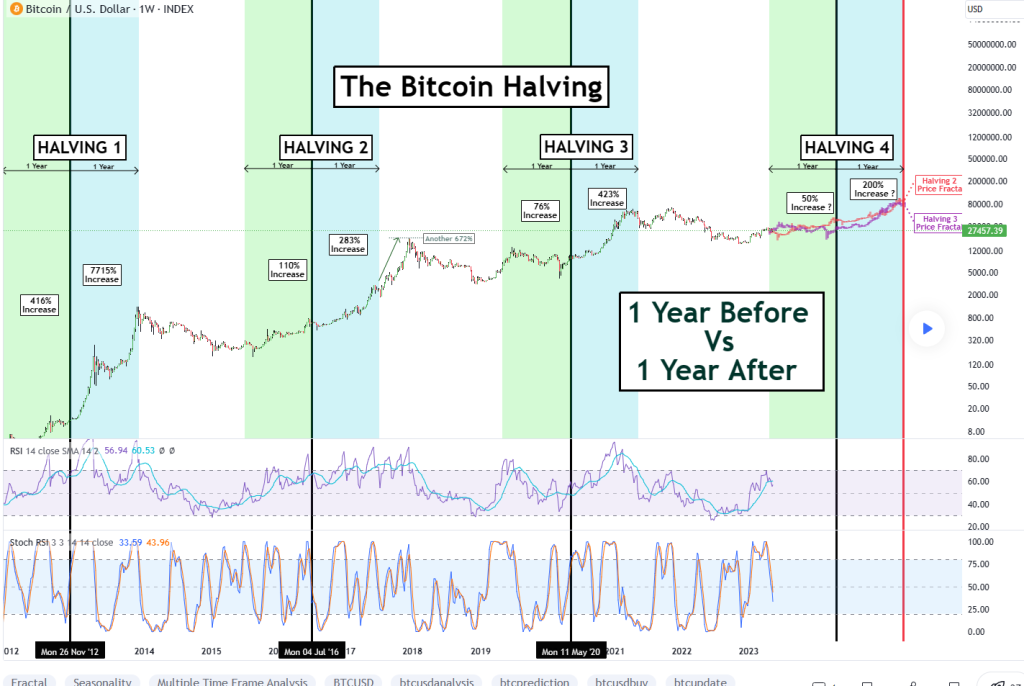A Bitcoin halving is a significant event that occurs roughly every four years, where the reward for mining a block is cut in half. This means that miners, who are responsible for adding new transactions to the blockchain and securing the network, receive 50% fewer bitcoins for their efforts.
The effort required to mine those blocks doesn’t change. The incentives at play don’t change. The cost of electricity or the time to mine the block remains the same, the only change is in the reward per block. Therefore for the companies that mine bitcoin will likely either slow down mining to cut costs of electricity, or push the price of bitcoin up to cover their costs just to maintain. This has happened before, after and just before the halving, the price rose. See below.

Bitcoin Halving’s Impact Analysis for INDEX:BTCUSD by PukaCharts — TradingView
Currently, Bitcoin is approximately 15,000 blocks away from its next halving, which is estimated to occur sometime in April 2024. This upcoming halving will see the block reward decrease from 6.25 BTC to 3.125 BTC.
Here are some potential consequences of the upcoming Bitcoin halving:
Reduced supply: With fewer new bitcoins being minted, the overall supply of Bitcoin will become scarcer. This could potentially lead to increased demand and a higher price, as scarcity is a fundamental driver of value.
Increased mining difficulty: As the reward for mining decreases, it may become less profitable for miners to participate in the network. This could lead to decreased hash rate, which is a measure of the computational power securing the Bitcoin network. A lower hash rate could make the network more vulnerable to attacks.
Market uncertainty: The halving is a major event that is often accompanied by significant price volatility. This is because there is no guarantee that the price will increase as a result of the reduced supply. In fact, the price could even fall in the short term if miners leave the network due to decreased profitability.
Historical price movements: Looking at previous halvings, there is some evidence to suggest that Bitcoin’s price does tend to increase in the months leading up to and following the event. For example, in the lead-up to the 2016 halving, Bitcoin’s price increased by over 300%. However, it is important to note that past performance is not necessarily indicative of future results.
Here are some additional things to keep in mind:
- The impact of the halving is not always immediate. It can take several months or even years for the full effects to be felt.
- Other factors, such as global economic conditions and regulatory changes, can also impact the price of Bitcoin.
- Predicting the future price of Bitcoin is always difficult and should not be considered financial advice.
Both hashrates and halving are fundamental concepts related to Bitcoin mining and its network dynamics. Here’s an explanation of their relationship:
- Hashrate:
- Hashrate refers to the computational power miners contribute to the Bitcoin network. In simpler terms, it measures the speed at which a miner solves complex mathematical problems to validate and add new transactions to the blockchain.
- A higher hashrate indicates a more secure and robust network because it would be extremely difficult for any single entity to control 51% of the network’s computational power, which would be required to carry out malicious activities like double-spending or rewriting transaction history.
- As more miners join the network and contribute their computational power, the total hashrate increases. Conversely, if miners leave the network or shut down their operations, the hashrate decreases.
- Halving:
- Bitcoin halving is an event programmed into the Bitcoin protocol, which occurs approximately every four years or after every 210,000 blocks have been mined. During this event, the reward that miners receive for validating and adding new transactions to the blockchain is halved. This reduction means miners receive 50% fewer bitcoins for their mining efforts.
- The primary purpose of the halving mechanism is to control the supply of new bitcoins entering circulation. By reducing the block reward, the rate at which new bitcoins are created slows down, leading to a capped supply of 21 million bitcoins.
- As a result of halving events, miners’ rewards decrease, potentially making mining less profitable for some miners, especially those operating older and less efficient hardware.
Relationship Between Hashrate and Halving:
- The relationship between hashrate and halving is indirect but interconnected. Here’s how:
- Economic Incentive: Before a halving event, miners anticipate the reduced rewards. Some may decide to upgrade their equipment or optimize their operations to maintain profitability after the halving. This can lead to a surge in hashrate as miners try to accumulate as many bitcoins as possible before the block reward reduction.
- Post-Halving Adjustments: After a halving event, if mining becomes less profitable for some miners due to reduced rewards, they might shut down their operations. This could lead to a temporary decline in hashrate as less efficient miners leave the network. However, over time, as the network adjusts, it can also lead to more efficient miners dominating the network, potentially increasing the overall hashrate again.
The Bitcoin halving events have historically had significant impacts on both the hashrate and the broader dynamics of the Bitcoin network. Here’s an overview of the historical impacts:
1. Impact on Hashrate:
- Anticipation of Halving: Prior to each halving event, there’s typically a surge in mining activity and hashrate. Miners are motivated to accumulate as many bitcoins as possible before the reward reduction. This can lead to increased competition among miners and a spike in computational power dedicated to mining activities.
- Post-Halving Adjustments: After a halving event, especially for miners operating older or less efficient hardware, the reduced rewards can make mining less profitable. Consequently, some miners may shut down their operations or upgrade their equipment to more efficient models. This can result in a short-term decline in the network’s hashrate as less efficient miners leave.
- Network Stability: Despite short-term fluctuations, the Bitcoin network has consistently demonstrated resilience post-halving. Over time, the network’s difficulty adjustment mechanism ensures that blocks are mined approximately every 10 minutes, regardless of changes in the hashrate. This mechanism helps stabilize the network and maintain its security.
2. Impact on Bitcoin Price and Market Dynamics:
- Price Speculation: Historical halving events have often been associated with increased speculation in the Bitcoin market. Traders and investors closely monitor these events, anticipating potential price movements. This heightened interest can lead to increased volatility in the weeks and months leading up to and following a halving.
- Supply and Demand Dynamics: With the halving reducing the rate of new Bitcoin issuance, there’s a decreased selling pressure from miners. If demand remains constant or increases, this reduced supply rate can create upward pressure on the Bitcoin price. Historically, both the 2012 and 2016 halvings were followed by significant price rallies in the subsequent months and years.
- Market Sentiment: The halving events also serve as a reminder of Bitcoin’s deflationary monetary policy. The capped supply of 21 million bitcoins and the periodic reduction in new supply through halvings underscore Bitcoin’s scarcity and can influence long-term bullish sentiment among investors.
3. Long-Term Implications:
- Maturation of the Ecosystem: With each halving event, the Bitcoin ecosystem has evolved and matured. The reduced block rewards have incentivized innovation in mining technology, leading to more efficient hardware and sustainable mining practices.
- Shift in Mining Geographies: Over time, the distribution of Bitcoin mining has shifted based on factors like energy costs, regulatory environments, and infrastructure development. Halving events can accelerate these shifts as miners seek optimal conditions for profitability.
Bitcoin halving events introduce short-term uncertainties and fluctuations, they play a crucial role in shaping the network’s long-term dynamics. Each halving underscores Bitcoin’s unique monetary properties and reinforces its position as a decentralized digital asset with a predictable and transparent monetary policy.
In summary, while hashrate and halving are distinct concepts in the Bitcoin ecosystem, they are interconnected. The anticipation and aftermath of halving events can influence miners’ behavior, leading to fluctuations in the network’s hashrate.









